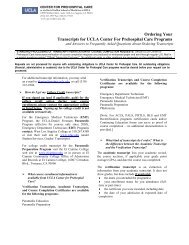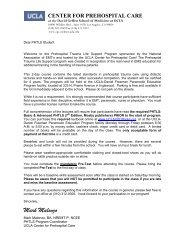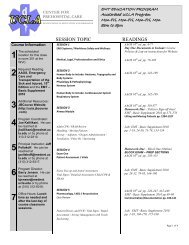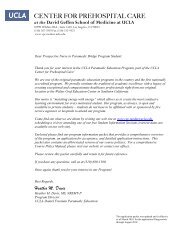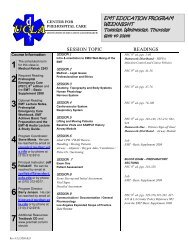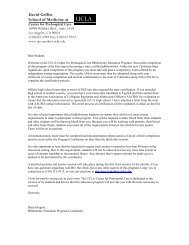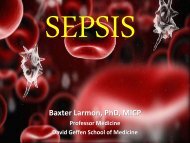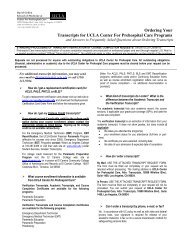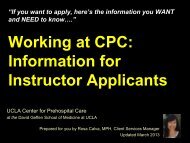EMT Policies (pdf) - UCLA Center for Prehospital Care
EMT Policies (pdf) - UCLA Center for Prehospital Care
EMT Policies (pdf) - UCLA Center for Prehospital Care
Create successful ePaper yourself
Turn your PDF publications into a flip-book with our unique Google optimized e-Paper software.
premises or at official Program functions; or possession of any property of the Program or<br />
others stolen while on Program premises or at official Program functions.<br />
• Computers. Theft or other abuse of computing facilities or computer time, including but not<br />
limited to unauthorized entry into a file to use, read, or change the contents or <strong>for</strong> any other<br />
purpose; unauthorized transfer of a file; unauthorized use of another individual's<br />
identification or password; use of computing facilities to interfere with the work of another<br />
student, faculty member, or Program official; use of computing facilities to interfere with a<br />
Program computing system.<br />
• Unauthorized Conduct. Unauthorized possession of, receipt of, duplication of, or use of the<br />
Program's name, insignia, or seal. Unauthorized entry to, possession of, receipt of, or use of<br />
any Program properties, equipment, resources, or services. Selling or distributing course<br />
lecture notes, handouts, readers, or other in<strong>for</strong>mation provided by an instructor, or using them<br />
<strong>for</strong> any commercial purpose, without the express permission of the instructor.<br />
• Physical Abuse. Physical abuse, including but not limited to rape, sexual assault, sex<br />
offenses, and other physical assault; threats of violence; or conduct that threatens the health<br />
or safety of any person.<br />
• Rape. Rape refers to "rape" as defined by the Cali<strong>for</strong>nia Penal Code (as it may be amended<br />
from time to time). Among other acts, the Penal Code prohibits the following acts:<br />
Sexual intercourse against a person's will accomplished by <strong>for</strong>ce or threats of<br />
bodily injury.<br />
Sexual intercourse against a person's will where the person has reasonable fear<br />
that she (or he) or another will be injured if she (or he) does not submit to the<br />
intercourse.<br />
Sexual intercourse where the person is incapable of giving consent, or is<br />
prevented from resisting, due to alcohol or drugs, and this condition was known,<br />
or reasonably should have been known by the accused.<br />
Sexual intercourse where the person is incapable of resisting because she (or he),<br />
at the time, is unconscious or asleep, and this is known to the accused.<br />
• Sexual Assault. The act of sexual assault includes <strong>for</strong>ced sodomy (anal intercourse); <strong>for</strong>ced<br />
oral copulation (oral-genital contact); rape by <strong>for</strong>eign object (<strong>for</strong>ced penetration by a <strong>for</strong>eign<br />
object, including a finger); and sexual battery (the unwanted touching of an intimate part of<br />
another person <strong>for</strong> the purpose of sexual arousal). These also include situations when the<br />
accused sexually assaults a complainant incapable of giving consent, including where the<br />
complainant is prevented from resisting due to alcohol or drugs and this condition was<br />
known, or reasonably should have been known by the accused.<br />
Note: For the purpose of this regulation, students should understand that:<br />
Forced intercourse or other unwanted sexual contact is defined as rape or sexual<br />
assault whether the assailant is a stranger or an acquaintance of the complainant.<br />
Page 12 of 39<br />
<strong>UCLA</strong> CPC Revised 12/10/2012



